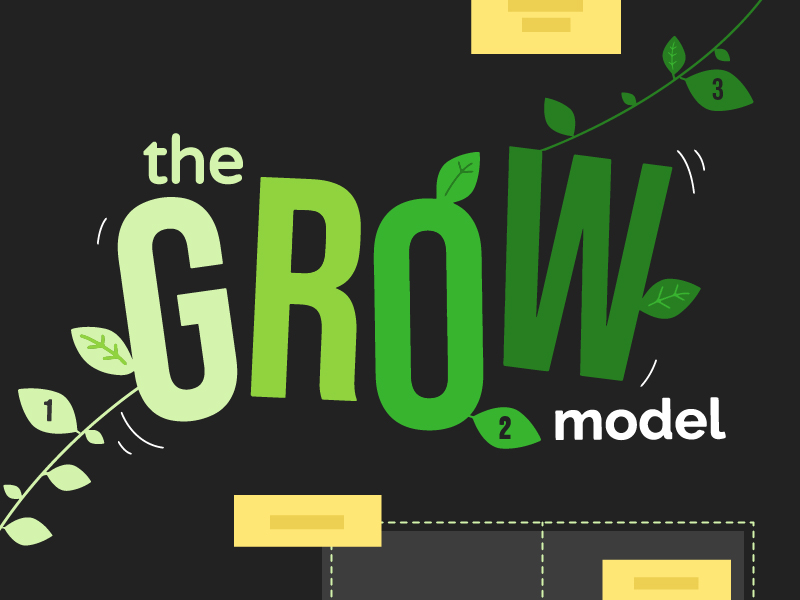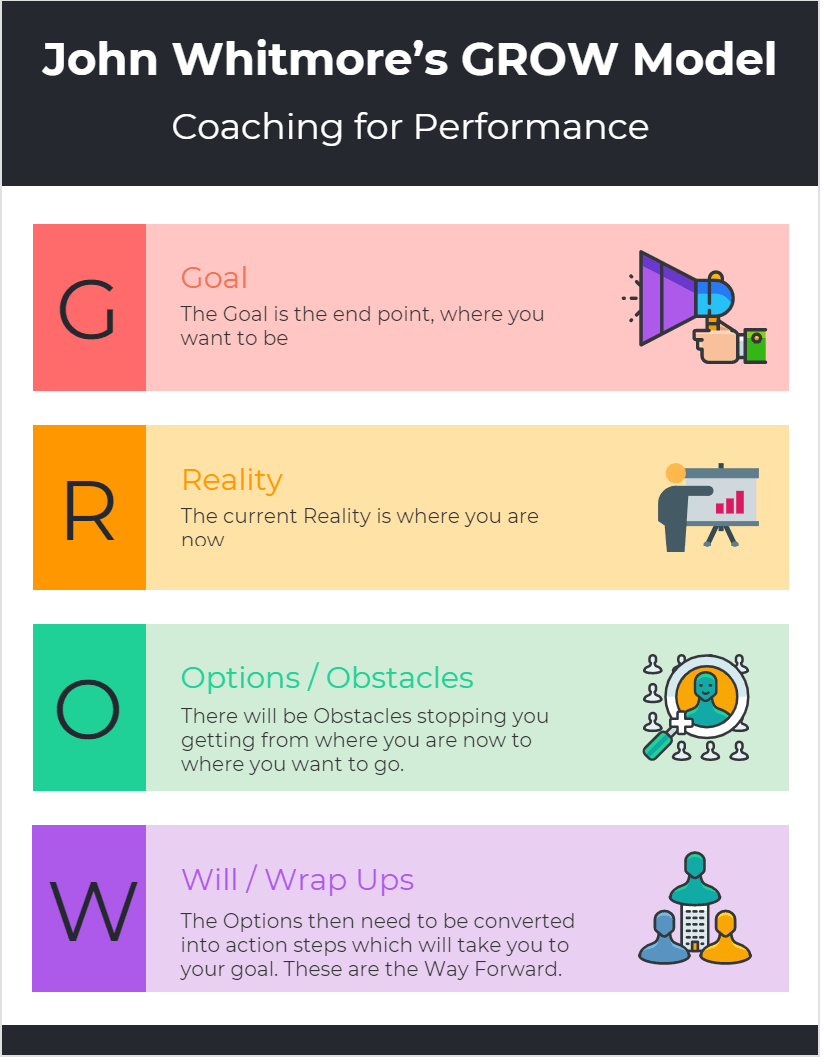A Guide to the GROW Model: Goal-Oriented Coaching and Counselling
The GROW model is a powerful tool used in coaching and counseling that helps individuals clarify their goals, overcome obstacles, and create action plans for success. Its goal-oriented approach and emphasis on client empowerment have made it a popular framework in various fields. In this blog post, we will explore the key components of the GROW model, understand its application in practice, and discuss its effectiveness backed by research.
Understanding
the GROW Model
The GROW model was developed by Sir John Whitmore, Graham Alexander, and Alan Fine in the 1980s. Sir John Whitmore, a renowned executive coach and author, is often credited as the primary architect of the GROW model. The model draws inspiration from various psychological theories, including cognitive behavioral therapy, humanistic psychology, and solution-focused brief therapy. They sought to create a framework that would empower clients to take ownership of their growth and development while providing a clear pathway for progress. The GROW model gained popularity in the field of coaching and counseling due to its simplicity, versatility, and emphasis on client empowerment. It has since been widely adopted and integrated into various coaching and counseling practices worldwide. It has become a foundational tool in goal-oriented coaching and counseling, helping individuals unlock their potential and achieve meaningful outcomes in their personal and professional lives.
The GROW model consists of four essential stages: Goal, Reality, Options, and Will. Each stage plays a crucial role in guiding clients towards their desired outcomes.
Goal Setting
The first stage of the GROW model is goal setting. Research has shown that setting clear and specific goals significantly improves performance and motivation (Locke & Latham, 2019). When using the GROW model, it is essential to help clients define SMART goals – Specific, Measurable, Achievable, Relevant, and Time-bound. SMART goals provide a sense of direction, focus, and clarity, enabling clients to stay motivated throughout their journey. Some questions you can ask include:
- What specific goal would you like to work towards?
- How would you define success in achieving this goal?
- Can you make your goal more specific and measurable?
- Is this goal achievable and realistic within the given timeframe?
- How does this goal align with your values and aspirations?
Assessing
Reality
The second stage of the GROW model involves assessing the current reality or situation. This step allows clients to gain a realistic understanding of their strengths, weaknesses, and external factors that may impact their progress. Active listening and empathy play a crucial role in this stage, as they create a safe space for clients to explore and reflect on their current circumstances.
You can ask the following questions to understand their current situation:
- What is your current situation or reality related to this goal?
- What strengths and resources do you have that can support you in achieving this goal?
- Are there any limitations or challenges that you need to consider?
- How do you feel about your current progress or lack thereof?
- What external factors may influence your progress towards the goal?
Generating Options
The third stage of the GROW model focuses on generating options or strategies. Research suggests that encouraging creative thinking and considering various alternatives enhances problem-solving abilities (Amabile, 2018). During this stage, coaches and counselors can help clients brainstorm different approaches, explore possibilities, and think outside the box. By expanding the range of options, clients increase their chances of finding effective solutions. Start by asking the following:
- What are some potential strategies or approaches you can consider to reach your goal?
- Can you brainstorm different alternatives or solutions?
- How have you successfully handled similar situations in the past?
- Are there any new perspectives or fresh ideas you can explore?
- What advice or suggestions would you give to a friend facing a similar challenge?
Creating Action Plans
The final
stage of the GROW model involves the will to create action plans. Research indicates that
individuals who develop specific action plans are more likely to achieve their
goals (Gollwitzer & Sheeran, 2006). In this stage, coaches and counselors
guide clients in selecting the best course of action from the identified
options. Together, they create action plans with clear steps, deadlines, and
accountability measures. This structured approach helps clients maintain focus
and track their progress effectively. The following questions can aid in action planning:
- Which option or strategy do you feel most motivated to pursue?
- What specific steps can you take to move closer to your goal?
- How will you measure your progress along the way?
- When do you plan to complete each step of the action plan?
- What support or resources do you need to ensure successful implementation?
Applying
the GROW Model in Practice
The GROW model has been successfully applied in coaching and counseling contexts, yielding positive outcomes. For example, a study by Grant and Cavanagh (2007) found that coaching interventions using the GROW model significantly enhanced self-efficacy and goal attainment among participants. The model's emphasis on client empowerment, collaborative problem-solving, and action-oriented strategies contributes to its effectiveness.
Here are
some tips on effective application of the model.
Establishing
a Collaborative Relationship
As a
counselor, it is crucial to establish a collaborative and trusting relationship
with your clients. This allows for open and honest communication, ensuring that
clients feel comfortable sharing their thoughts, feelings, and challenges. Building
rapport and demonstrating empathy are essential in creating a safe and
non-judgmental space for clients to explore their goals and aspirations.
Tailoring
the GROW Model to Individual Needs
Each client
is unique, and their goals and challenges may differ. It's important to adapt
the GROW model to suit their specific needs and preferences. This may involve
modifying the language, pacing, or order of the stages to best support the
client's progress. Flexibility and a client-centered approach are key in
ensuring that the GROW model is effectively applied.
Encouraging
Reflection and Self-Awareness
Throughout
the GROW model process, encourage clients to reflect on their experiences,
thoughts, and emotions. By fostering self-awareness, clients can gain deeper
insights into their strengths, values, and potential barriers. Reflective
questioning can help clients explore their beliefs, assumptions, and patterns
of behavior that may be influencing their progress towards their goals.
Accountability
and Progress Tracking
The GROW
model emphasizes the importance of setting specific and measurable goals.
Encourage clients to track their progress, whether through regular check-ins,
journaling, or using goal-tracking tools. Accountability plays a vital role in
maintaining motivation and focus. Celebrating milestones and acknowledging
achievements along the way can boost clients' confidence and reinforce their
commitment to their goals.
Flexibility
and Adaptability
As clients
progress through the GROW model, it's essential to remain flexible and open to
adjustments. Circumstances may change, and clients may encounter unexpected
challenges or opportunities. Be prepared to revise action plans, explore
alternative strategies, and adapt the coaching approach to best support the
client's evolving needs.
Evaluation
and Learning
At the end
of the GROW model process, it is valuable to evaluate the effectiveness of the
coaching intervention. Encourage clients to reflect on their overall progress,
the challenges they faced, and the strategies that worked well for them. This
reflection promotes learning and growth, empowering clients to apply their
newfound skills and insights to future goals beyond the scope of the coaching
relationship.
By applying
the GROW model in practice, counselors can facilitate positive change, empower
clients to overcome obstacles, and achieve their desired outcomes. Remember,
each client's journey is unique, and the GROW model provides a framework that
can be adapted and personalized to suit their individual needs and aspirations.
Conclusion
The GROW
model is a valuable framework that provides a structured and goal-oriented
approach to coaching and counseling. Its effectiveness in helping clients
clarify goals, assess reality, generate options, and create action plans has
been supported by research. By utilizing the GROW model, coaches and counselors
can empower individuals to achieve their desired outcomes, overcome challenges,
and experience personal growth.








Comments
Post a Comment